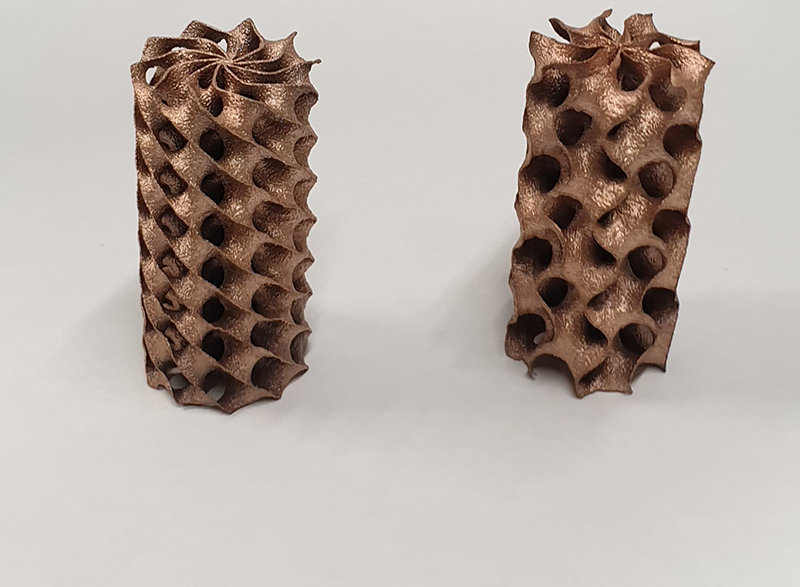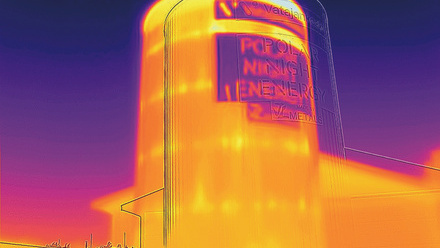3D-printable copper-silver alloys
3D-printable, high-purity copper-silver alloys demonstrate improved strength and heat transfer performance for automotive, aerospace and healthcare components compared to current alternatives.

Researchers at the University of Wolverhampton, UK, claim to have created, for the first time, 3D-printable, high-purity (>99%) copper-silver alloys that demonstrate improved strength and heat transfer performance for automotive, aerospace and healthcare components compared to current alternatives.
The study is led by the Additive Manufacturing of Functional Materials (AMFM) research group. They explain that highly reflective materials such as silver (Ag) and copper (Cu) are known to be challenging for laser 3D printing processes, due to laser energy reflection and heat dissipation hindering material meltpool generation.
The group's research into the powder feedstock’s pore morphology and distribution has helped to identify the spherical morphology and size and shape of the Ag and Cu particles that enhance packing density and powder flowability for the laser powder bed fusion (L-PBF) AM process. This, in turn, improves pore density and reduces defects. The parametric combination that has been developed enables laser processing of high-purity Ag, Cu and Cu-Ag alloys using a standard 400W infrared L-PBF system. The researchers are soon to release a paper outlining the desired particle characteristics to achieve this.
'The results reported in this study demonstrate the potential to manipulate 3D-printed component strength and thermal performance through material composition and resultant microstructure,' explains Dr John Robinson, Senior Engineering Technician at the University.
'Controlling a material’s performance through the manipulation of the manufacturing process to modify the resultant microstructure is becoming more popular in research publications…[and] numerous academic institutes (and the additive manufacturing industry) are completing great work on application specific materials, however, there was – and still is – a gap in knowledge regarding the laser AM processing of highly reflective Cu-Ag alloys for heat management applications.
'Using L-PBF in situ alloying methods have allowed us to characterise varying composition Cu and Ag alloys rapidly and report the enhanced performance results.'
Robinson explains that the research team has developed both L-PBF scanning strategies and laser parameters for Cu and Ag simultaneously to overcome the challenges of laser 3D printing such materials. 'This process optimised laser energy density at the powder bed for specific regions of the build,' he adds.
The processed materials have subsequently been tested for their relative density, mechanical and thermal performance using X-ray computed tomography, destructive tensile testing and laser flash apparatus.
Robinson says, 'Novel Cu-Ag alloys outperformed both pure Ag, pure Cu and all commercially available Cu materials evaluated, exhibiting 84%, 100% and 106% higher yield strengths in comparison to commercially available Cu, CuCP and chromium zirconium copper, while ultimate tensile strength values were 91%, 62% and 82% higher.'
Researchers have found that pure Ag’s thermal diffusivity performance is 70% higher than pure Cu, however, the addition of Ag to Cu increases thermal diffusivity by 6.2% in the material compositions studied.
'In Cu-Ag alloys, Cu-Ag interfaces hinder dislocation movements and therefore the addition of Ag to Cu has strengthening effects due to an increase in Cu-Ag phase boundaries,' Robinson explains. 'Furthermore, heat treatment processes resulted in atomic lattice contractions and recrystallisation which had a significant impact on mechanical performance due to stronger binding effects.'
Robinson adds, 'It is widely agreed that the localised high heat fluxes and non-uniform heat dissipation requirements for many industries will require advances in materials and manufacturing technologies to effectively dissipate the thermal loads for future systems and devices. High performance
Cu-Ag materials, combined with lightweight lattice structures and large surface area geometries, are now opening up applications for aerospace and automotive where weight and thermal management are significant considerations.'
The team is currently investigating electric vehicle battery thermal management and electrical machine applications.






